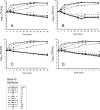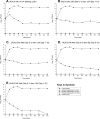Front-loaded linezolid regimens result in increased killing and suppression of the accessory gene regulator system of Staphylococcus aureus
- PMID: 22526313
- PMCID: PMC3393439
- DOI: 10.1128/AAC.05453-11
Front-loaded linezolid regimens result in increased killing and suppression of the accessory gene regulator system of Staphylococcus aureus
Abstract
Front loading is a strategy used to optimize the pharmacodynamic profile of an antibiotic through the administration of high doses early in therapy for a short duration. Our aims were to evaluate the impact of front loading of linezolid regimens on bacterial killing and suppression of resistance and on RNAIII, the effector molecule of the accessory gene regulator system (encoded by agr) in methicillin-resistant Staphylococcus aureus (MRSA). Time-killing experiments over 48 h were utilized for linezolid against four strains of MRSA: USA100, USA300, USA400, and ATCC 29213. A hollow-fiber infection model simulated traditional and front-loaded human therapeutic regimens of linezolid versus USA300 at 10(6) CFU/ml over 240 h. Over 48 h in time-kill experiments, linezolid displayed bacteriostatic activity, with reductions of >1 log(10) CFU/ml for all strains. Front-loaded regimens that were administered over 5 days, 1,200 mg every 12 h (q12h) (total, 10 doses) and 2,400 mg q12h (total, 10 doses) followed by 300 mg q12h thereafter, resulted in sustained bactericidal activity, with reductions of the area under the CFU curve of -6.15 and -6.03, respectively, reaching undetectable limits at the 10-day study endpoint. All regimens displayed a reduction in RNAIII relative expression at 24 h and 240 h compared with that of the growth control. Monte Carlo simulations predicted a <1.27× increase in the fractional decreases in platelets for all front-loaded regimens versus the 600 mg q12h regimen, except for the highest-dose front-loaded regimen. Front-loading strategies for linezolid are promising and may be of utility in severe MRSA infections, where early aggressive therapy is necessary.
Figures






References
Publication types
MeSH terms
Substances
Grants and funding
LinkOut - more resources
Full Text Sources
Molecular Biology Databases

